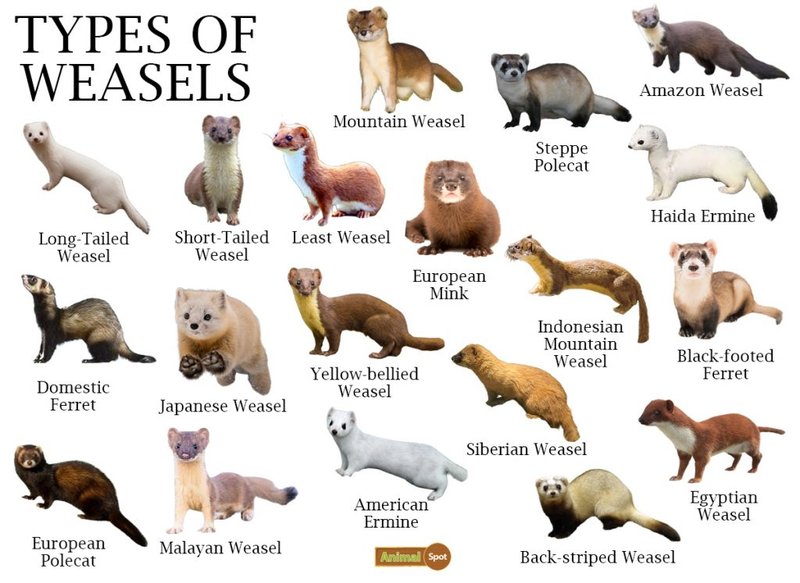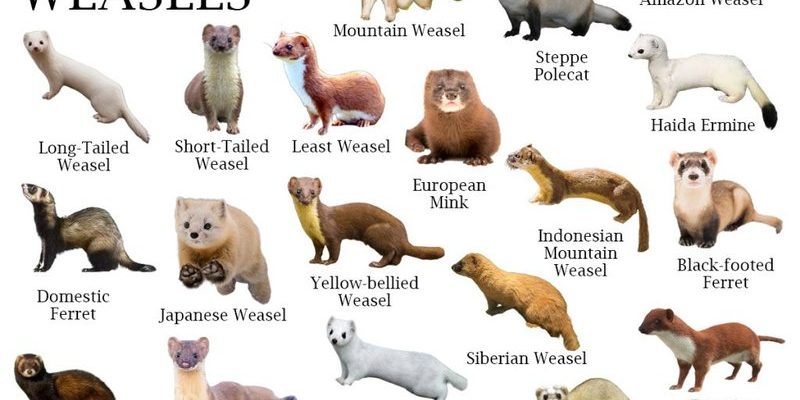
In this article, we’ll explore ten animals that resemble weasels. Each of these creatures has its own quirks, habitats, and behaviors that set them apart, even if they look somewhat similar at first glance. So grab a cup of coffee, and let’s dive into the fascinating world of mustelids and their lookalikes!
1. Stoat (Short-tailed Weasel)
The stoat, also known as the short-tailed weasel, is one of the closest relatives to the weasel. These charming little critters are often found in northern regions and have a distinctive coat that changes color with the seasons. In summer, their fur is a rich brown, while in winter, it transforms into a dazzling white, making them look like tiny snowballs.
So, how can you tell a stoat apart from a regular weasel? Well, one of the main differences lies in their size. Stoats tend to be a bit larger, averaging about 12 to 30 inches in length, including their tail. Plus, they often sport a black tip on their tail, which is a neat distinguishing feature.
2. Ferret
Ferrets are domesticated members of the weasel family, and their playful nature makes them popular pets. These little furballs are longer and more robust than weasels, usually weighing between 1.5 to 4 pounds. With a variety of colors and patterns in their fur, ferrets bring a burst of personality wherever they go.
One way to tell a ferret from a weasel is by their behavior. Ferrets love to play and explore, often rolling around and darting in and out of hiding spots. If you see something furry doing acrobatics, it’s likely a ferret and not a wild weasel.
3. Mink
Minks are another close relative to weasels and are known for their luxurious fur. They often dwell near water sources, like rivers and lakes, and have a sleek, elongated body that helps them navigate through their aquatic habitats. Minks are slightly larger than weasels, usually measuring around 24 to 28 inches in length.
If you spot an animal that looks like a weasel but seems a bit bulkier and has a more vibrant coat, chances are you’re looking at a mink. Their fur is typically darker and shinier, and they often have a more robust build. Plus, minks are excellent swimmers, so if you see one gliding through water, it’s definitely not a regular weasel!
4. Marten
Martens are tree-dwelling animals that belong to the mustelid family, just like weasels. They have a distinctive bushy tail and a sleek body, making them look somewhat similar to their smaller cousins. Martens can be found in forests across Europe, Asia, and parts of North America.
To distinguish martens from weasels, look for their facial markings. Martens often have a light-colored patch on their throat or chest, giving them a more striking appearance. They also tend to be a bit larger than weasels, with an average length of 19 to 25 inches.
5. Otter
Otters may look quite different from weasels at first glance, but they are members of the same family. These playful and social creatures are usually found in aquatic environments and are great swimmers, thanks to their long, streamlined bodies. Otters can weigh anywhere from 50 to 100 pounds!
So, how do you tell an otter from a weasel? For starters, otters are much larger and bulkier. Their playful nature also sets them apart—if you see an animal sliding down mudbanks or frolicking in water, you’re definitely looking at an otter, not a weasel.
6. Badger
Badgers are stocky, muscular animals that have a more robust build compared to weasels. They’re known for their distinct black-and-white facial markings and their burrowing habits. Badgers can be found in various habitats, from meadows to forests, and they play an essential role in their ecosystems.
The most notable difference between badgers and weasels is their size. Badgers are significantly bigger, weighing between 15 to 30 pounds. Additionally, badgers have shorter legs and a broader head. If you spot a lumbering creature with a distinctive face, it’s likely a badger and not a weasel.
7. Skunk
Skunks are famous for their strong scent, but they also belong to the mustelid family, making them distant relatives of weasels. They have a unique appearance, usually with black fur and white stripes running along their backs. Skunks can range from about 18 to 30 inches in length.
One of the easiest ways to tell a skunk from a weasel is by their shape and size. Skunks have a more rounded body and a bushy tail, which they raise when they feel threatened. If you see an animal with a tail waving in the air and a plump body, it’s definitely a skunk!
8. Civet
Civets might not be as closely related to weasels as some of the others on this list, but they share a few features that can confuse even the sharpest observers. Civets are small, nocturnal mammals found mainly in Africa and Asia, and they have elongated bodies like weasels.
To differentiate between a civet and a weasel, observe the facial features and markings. Civets typically have longer snouts and distinctive markings on their fur, sometimes resembling spots or stripes. Their more pronounced facial features and bushier tails are good indicators that you’re looking at a civet.
9. Fisher
Fisher cats, despite their name, are not felines but members of the weasel family. They are medium-sized mammals that typically inhabit wooded areas in North America. Fisher cats are known for their agility and are excellent climbers, much like cats.
If you come across a fisher, you’ll notice they have a thicker, more muscular body compared to a weasel. Their fur is dark brown, and they have a long, bushy tail. The way they move through the trees and their size can clue you in that it’s a fisher and not a weasel.
10. Sea Otter
Last but not least, the sea otter is another fascinating relative of the weasel. These marine mammals are known for their luxurious fur and playful behavior. They float on their backs, using stones to crack open shellfish, showcasing their intelligence.
The main difference between a sea otter and a weasel lies in their habitat and size. Sea otters can weigh up to 100 pounds and live in marine environments, unlike weasels, which prefer terrestrial habitats. Their larger, rounder bodies and unique behaviors make them stand out nicely against the weasel.
Now that you’ve met ten animals similar to the weasel, you can appreciate the diversity within the mustelid family and their cousins. Each of these creatures has its own unique features and behaviors that make them special. Whether you’re observing them in the wild or reading about them from the comfort of your home, understanding these similarities and differences helps deepen our connection with the natural world.
So the next time you spot a quick little critter darting through the grass or playing near water, you’ll have a better idea of what it might be. Just remember, while these animals share some traits with weasels, each one is a unique member of the animal kingdom, deserving of our curiosity and admiration!

